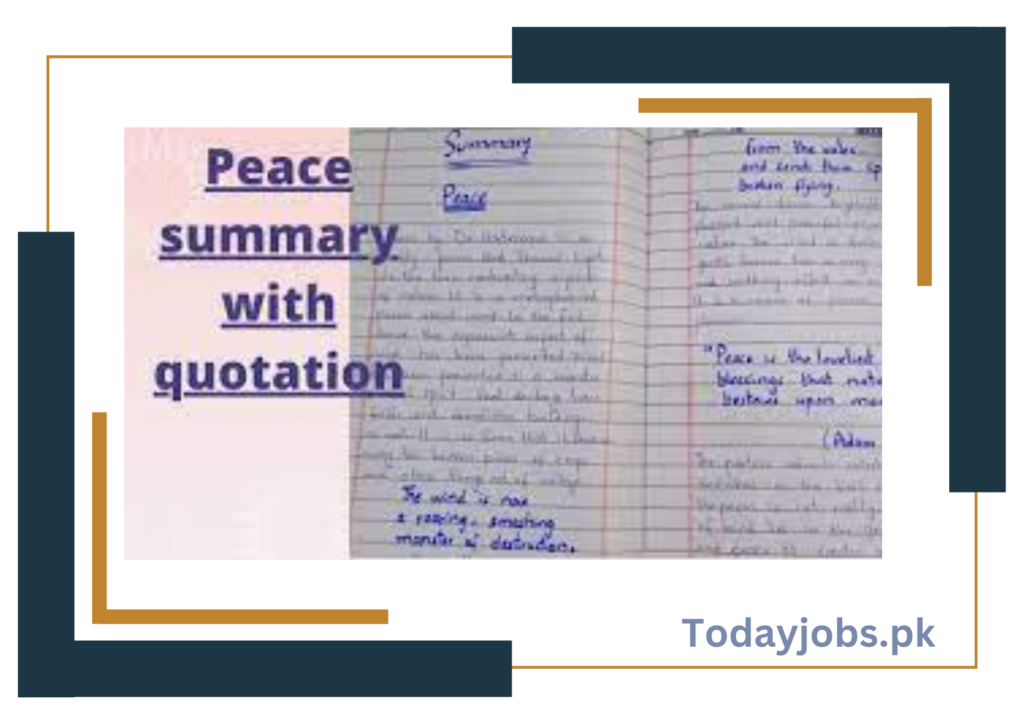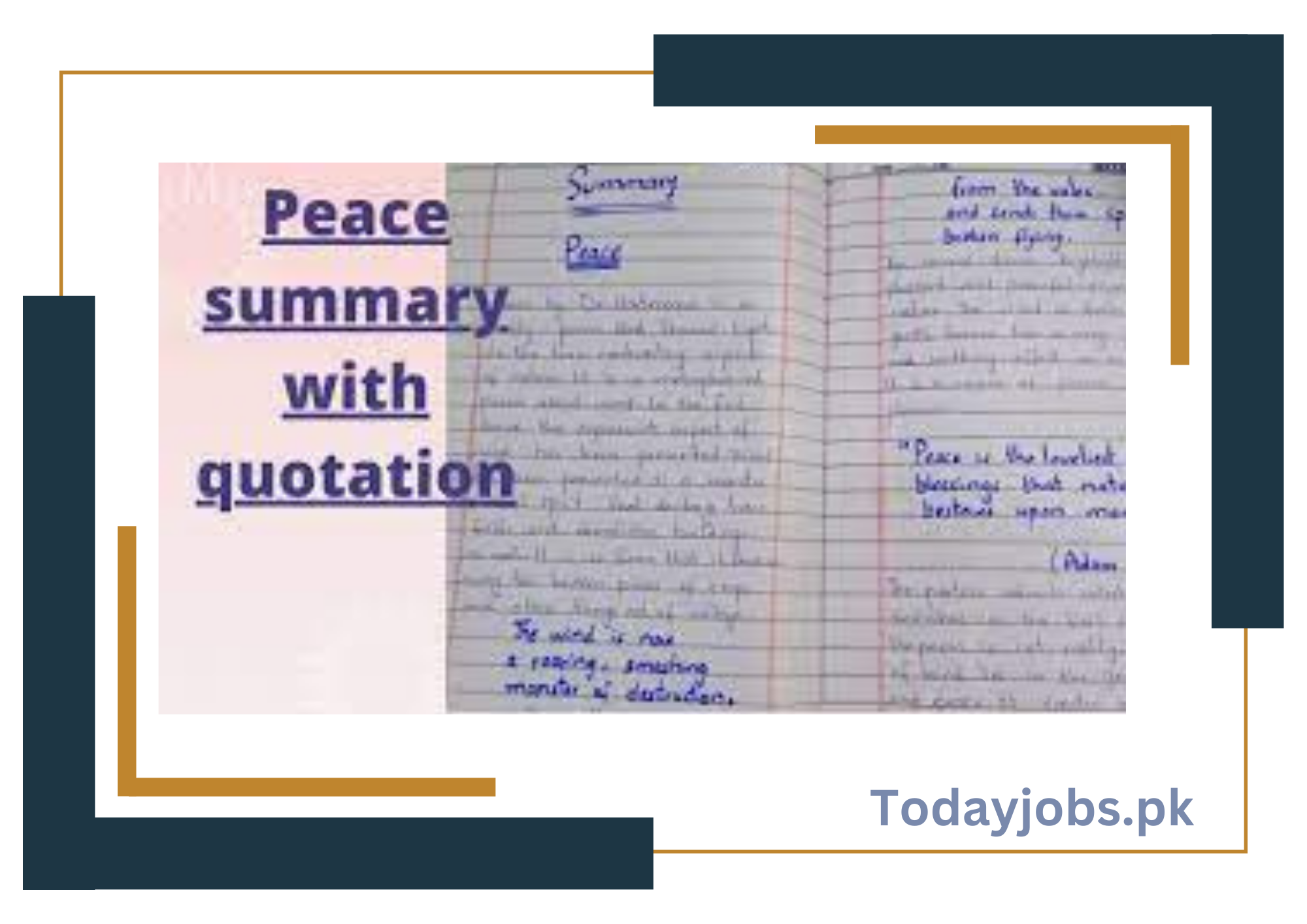Peace Summary 10th Class Quotations are given on this page. Your ultimate resource for academic excellence. In this article, we delve into a comprehensive analysis of the poem “Peace” for 10th-class students. Our aim is to provide you with a detailed understanding of the central ideas and themes encapsulated in this thought-provoking poem. Through this analysis, we hope to enhance your appreciation for the beauty and depth of poetic expression while empowering you to excel in your academic pursuits.
Peace Summary 10th Class Quotations | Poem Overview

Central Idea of the Poem “Peace”
The poem “Peace” serves as a medium through which nature imparts valuable lessons to humanity, employing various elements such as wind, water, mountains, and light. It elucidates the transformative power of wind, showcasing its ability to both destroy and create. The poet emphasizes the notion that experiencing storms is essential for attaining true peace.
Easy Version
In the initial verses, the poetess portrays the wind as a force of destruction. During storms, it ravages trees, fields, and buildings, leaving devastation in its wake. However, the poem takes a turn, presenting wind in its gentler form—a cool breeze that breathes life into buds, birds, and humans. This contrast illustrates nature’s ability to bring forth harmony amidst the chaos.
Standard Version
Expanding upon the easy version, the standard rendition of the poem further explores the multifaceted nature of wind. The poetess, Dr. Hartmann, skillfully employs language to depict the intricacies of this element. Despite the simplicity of the poem’s language, it conveys a unique perspective on the wind, leaving readers with a profound message: The journey to finding peace often entails confronting and weathering storms.
Detailed Analysis
The poem “Peace” is a testament to the poetess’s acute observation of life and her profound appreciation for nature. Its descriptive and captivating portrayal of wind reflects the poetess’s deep connection with the natural world. Although the language employed is simple, it effectively captures the essence of wind in a distinctive manner. This thought-provoking poem showcases the poetess’s mastery of words and ideas.
Peace Summary 10th Class Quotations List
To further enrich your understanding of the theme of peace, here are some Peace Summary 10th Class Quotations that resonate with the essence of the poem Spech on Iqbal Day check here. These quotations can serve as valuable additions to your 10th class summary:
1. “Peace cannot be kept by force; it can only be achieved by understanding.” – Albert Einstein
2. “If you want to make peace with your enemy, you have to work with your enemy. Then he becomes your partner.” – Nelson Mandela
3. “Peace begins with a smile.” – Mother Teresa
4. “An eye for an eye will only make the whole world blind.” – Mahatma Gandhi
5. “Peace is not the absence of conflict, it is the ability to handle conflict by peaceful means.” – Ronald Reagan
6. “The pursuit of peace and progress cannot end in a few years in either victory or defeat. The pursuit of peace and progress, with its trials and its errors, its successes and its setbacks, can never be relaxed and never abandoned.” – Dag Hammarskjöld
7. “Peace is not something you wish for; it’s something you make, something you do, something you are, and something you give away.” – John Lennon
8. “Peace is not the product of a victory or a command. It has no finishing line, no final deadline, and no fixed definition of achievement. Peace is a never-ending process, the work of many decisions.” – Oscar Arias
9. “If you want peace, you don’t talk to your friends. You talk to your enemies.” – Desmond Tutu
10. “Let us not be content to wait and see what will happen, but give us the determination to make the right things happen.” – Peter Marshall
FAQS
What is the summary of the poem What is peace?
The poem “What is Peace?” by Pablo Neruda is a reflection on the meaning of peace. The speaker asks a series of questions about what peace is and how it can be achieved. He suggests that peace is not simply the absence of war, but also a state of mind and a way of life. Peace, he says, is about love, compassion, and understanding. It is about living in harmony with oneself, with others, and with the natural world.
What is the theme of the poem peace?
The theme of the poem “What is Peace?” is the importance of peace. The speaker argues that peace is not just a luxury, but a necessity. He says that without peace, there can be no happiness, no prosperity, and no hope for the future. Peace, he says, is the foundation upon which all other good things in life are built.
What is the central idea of the poem Peace Class 10?
The central idea of the poem “What is Peace?” in Class 10 is that peace is not just the absence of war, but also a state of mind and a way of life. Peace, the speaker says, is about love, compassion, and understanding. It is about living in harmony with oneself, with others, and with the natural world.
Who wrote the poem Peace?
The poem “What is Peace?” was written by Pablo Neruda, a Chilean poet who was awarded the Nobel Prize in Literature in 1971. Neruda was a prolific writer who produced a vast body of work, including poetry, novels, and short stories. His work is known for its beauty, its passion, and its commitment to social justice.
Conclusion
In conclusion, the poem “Peace” serves as a profound exploration of the power of nature and its capacity to teach humanity invaluable lessons. By analyzing the poem’s central ideas and themes, we have delved into the intricacies of wind, highlighting its ability to both destroy and bring forth peace. Additionally, we have shared enlightening quotations that further reinforce the importance of peace in our lives.
